Flower painting by Ambrosius Bosschaert II
by Mary Kempski
Retouching
Paintings need retouching when a loss of paint has caused a visual disunity in the painting. Retouchings, re-creating the completed image once again, can be of enormous service to the reading and appreciation of the artistic intention. The retouching must imitate the surrounding area of paint in tone and texture and in most cases make the viewer unaware of any damage.
Egg Tempera
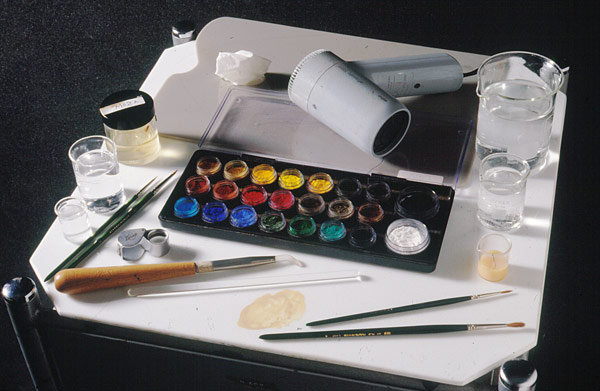 |
||
|
Tools for tempera retouching, including dry pigments, brushes, burnishing tool, egg tempera, and synthetic varnish |
||
The choice of medium for retouching an aged painting is of the utmost importance. At the Hamilton Kerr Institute we often use egg tempera as the medium of choice, even when retouching a painting in oil. This is because oil paint becomes more transparent over time and each layer of the artist’s paint will have an optical effect on the subsequent layer. Egg tempera paint can imitate this effect perfectly, when the consecutive paint layers employed by the artist are followed in the retouching. This includes all the layers consisting of coloured grounds, opaque laying-in layers and transparent glazes. The very final matching touches are applied using a synthetic varnish resin rather than egg tempera as the medium. The retouching is also varnished with the same synthetic varnish throughout the process producing a retouching with the same solubility as the varnish for future reversibility.
Other advantages for using egg tempera as a retouching medium are numerous:
- Tempera is a healthy option, using simply egg, pigments and water.
- Retouchings can be made cleanly and precisely.
- Tempera can be used in certain cases for the final touches of a retouching, even after glazing, where precise or minute details are required.
- It is fast drying.
- It is without risk of discolouration, particularly if the glazes in resin are kept to a minimum.
- When a retouching is completed entirely in tempera, with stable pigments, then virtual colour permanence can be assumed.
- Tempera, once it has dried, is less hygroscopic than either gouache or water colour.
- It is possible to use this retouching medium on paintings dating from medieval to modern times, of varying media.
Egg tempera retouching is documented as having been in use in Germany in the 19thcentury. Helmut Ruhemann, amongst others, brought the technique of tempera retouching from Germany to England at the beginning of the twentieth century. The use of tempera retouching was then passed on to Ruhemann’s pupil, Herbert Lank, who worked with Ruhemann at the National Gallery, London. In 1977 the Hamilton Kerr Institute was founded and Herbert Lank became its first director. He continued to teach the virtues of egg tempera retouching to his students at the Hamilton Kerr Institute and it carries on being used and taught today. Although this is not an easy medium for the beginner, due to the ‘indirect’ method of colour matching (i.e. the tempera paint will go through four different colour changes during the process beginning with paint on the palette to finished retouching on the painting) once the method has been mastered egg tempera is one of the most rewarding of media and favoured by many conservators over other modern synthetic media alternatives. Below is an example of imitative retouching using egg tempera.
The reconstruction of flowers in a painting by Ambrosius Bosschaert II using the egg tempera technique
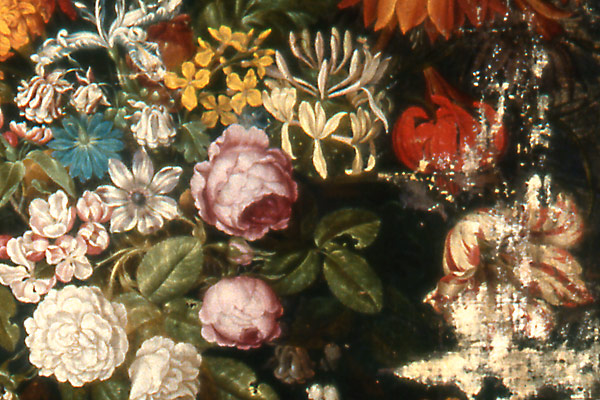 |
||
|
The non-original paint and varnish has been removed, revealing the paint damage |
The painting by Ambrosius Bosschaert II, A vase of flowers with a monkey, was painted in oil around 1635 and is owned by the Fitzwilliam Museum. On arrival at the Institute, it was clear that the varnish was very discoloured and that the painting had been heavily overpainted in the background. The overpaint had been poorly applied and distracted from the quality of the original painting. X-ray analysis revealed a great deal of original paint loss in the painting, but most of the flowers remained in good condition. The image on the left shows an area of the painting with varnish and non-original paint removed, revealing the extent of damage. After discussion with the the museum it was decided that the discoloured varnish and retouchings should be removed and the losses should be imitatively retouched to unify the image once again. Egg tempera was chosen as the medium for retouching.
Layers of tempera were built up on top of a fill material to form a similar structure to that of the original. A double ground was applied: a red-brown layer first, seen on the left, followed by a buff-coloured layer, seen on the right, below. Reconstructing the ground layers helps to achieve a similar tonal range to the original for the layers applied above.
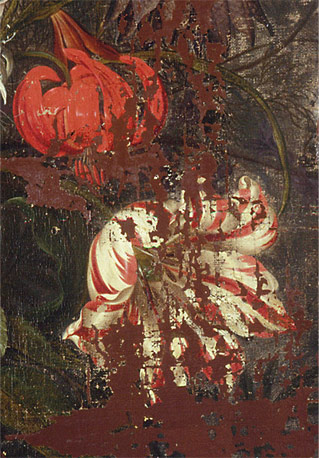 |
||
|
The first tempera layer |
||
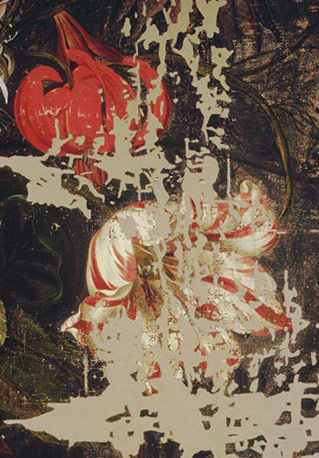 |
||
|
The second tempera layer |
||
The paint losses in the flowers were built up in layers, as seen on the left. Original fragments of paint were used as a guide to reconstruct the missing areas. In retouching, the accuracy of matching the texture of original paint (from, for example, impasto or canvas weave) is just as important as a good colour match. In some areas of the flowers, the canvas texture had been lost, making the retouching appear too smooth. In these areas Mowiol 4-88, a polyvinyl alcohol diluted with water and mixed with chalk, was dotted onto the surface to suggest the texture of the canvas.
Once the layers of egg tempera had been built up sufficiently, the final glazes were added, consisting of dry pigments in a synthetic varnish. This layer completed the appearance of aged oil paint, achieving the subtle tonal variations and the depth and richness of the original painting. The image below shows the tulip, lily and fritillary after this process of reconstruction.
The image below right shows the finished retouching, the painting is on display in the Fitzwilliam Museum.
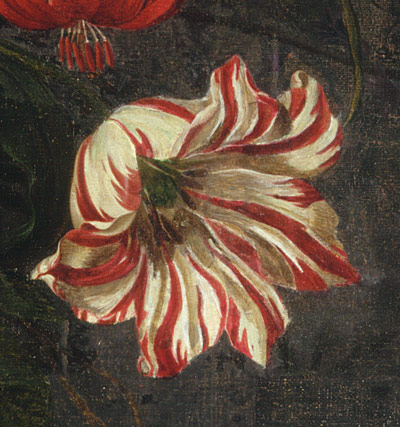 |
||
|
The retouching in progress, before final glazes |
||
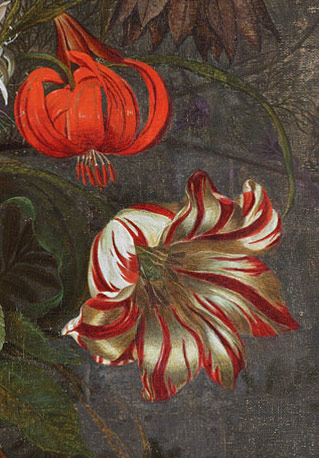 |
||
|
Completed effect |
||
